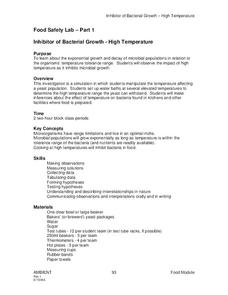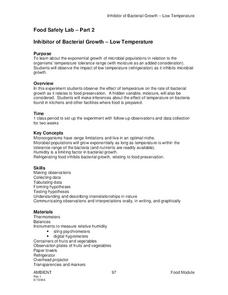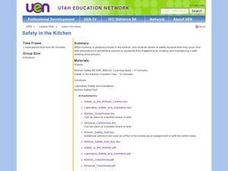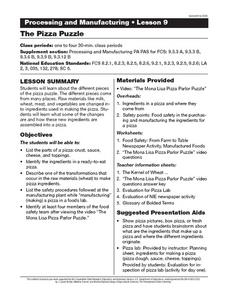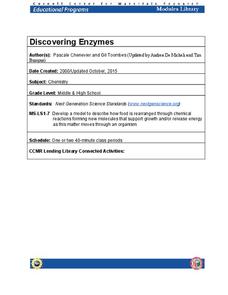Curated OER
Food Safety Lab
Students determine the optimal living conditions for yeast and apply these results to microbes in food. In this microbiology lab instructional activity, students observe the reaction of yeast to elevated temperatures. They relate these...
Curated OER
Food Safety Lab
Students use the scientific method to investigate the role of temperature in microbial growth. In this food preservation lesson, students set up an experiment with fruit in room temperature and in a refrigerator. They record the...
Learning Games Lab
Controlling Water Activity in Food
Food storage matters! Scholars learn how the amount of water in corn can affect its rate of spoilage. They create a control group, then test three corn samples stored in three different locations for water activity. As a result of the...
Curated OER
Food and Kitchen Safety Lab
Students review kitchen management, safety, and sanitation rules, and practice applying safety and sanitation rules in kitchen lab by preparing chicken stir-fry over rice while maintaining safe working environment. Students then complete...
Curated OER
Educate Yourself About Food Borne Illness
High schoolers explore the rules to food safety and how to keep foods from growing bacteria. In this food illness lesson students view a demonstration about bacteria complete a food safety test online.
Curated OER
Food Safety Lab-Part 3 Cross Contamination andHygiene
Learners observe the effect of croos contamination as they inoculate orange juice with penicillin mold from the refrigeration lab and active yeast solution from the sterilization lab. They experience a simulation of passing bacteria...
Learning Games Lab
The pH Scale and Meter Calibration
What are the different ways to test for pH? First, scholars explore the pH scale and a common way to test for acidity and alkalinity. Then, they learn about the importance of pH in food safety and why variance in pH could potentially...
Learning Games Lab
Gram Staining
Scholars use a lab simulation to test contaminated yogurt for bacteria by gram staining. They learn proper lab procedures for handling bacteria and for sterilizing equipment, and then walk through the process on their own to try gram...
Learning Games Lab
Testing and Adjusting pH
Pupils learn how to control food spoilage by adjusting the food's pH. They see that one of the most dangerous bacteria can grow in food if people don't handle and store food properly. Using knowledge of the bacteria's preferred pH,...
Utah Beef Council
Beef Unit and Lab Plan
What are the proper methods for cooking various cuts of beef? What are some basic rules regarding meat food safety? Here you'll find 10 lab plans with a variety of beef cookery activities, perfect for a home economics or cooking course.
Teach Engineering
Powering a Device Using Food
Eat up a resource on using food to power electrical devices. Future engineers first experiment with different fruits and vegetables to determine the amount of electrical energy they provide. Based on the data, they design and create an...
Chymist
The Extraction and Identification of Artificial Food Colors
Did you know some food dyes are considered safe while others are considered carcinogenic? During the experiment, young chemists extract artificial food colors from prepared foods. Then, they use chromatography paper to identify which...
Curated OER
Laboratory Safety Rules
A one-page contract commits your science pupils to safety in the laboratory. Included in these nine rules is a list to fill in locating emergency equipment and important phone numbers. Every laboratory class should begin with a...
Curated OER
Genetically Modified Food (GMF)
Explore genetically modified foods through various experiments. In this biology lesson, students discuss the safety issues related to GMF's. They conduct a PCR analysis to identify the presence of genetic modification.
Learning Games Lab
Understanding Water Activity
How does water activity play a role in food spoilage? First, the learners think about which types of foods would be best to take on a backpacking trip based on the water activity of different foods. It then walks through why water...
Learning Games Lab
How to Use Oil Immersion Microscope
Teach the class how to use a microscope to identify bacteria in food. Scholars explore the different parts of the microscope and learn how to determine total magnification. They walk step-by-step through the procedure of preparing slides...
Curated OER
Safety in the Kitchen
Students apply established safety rules and guidelines to maintain a safe working environment. They survey safety hazards that may occur and take precautions in preventing injuries or accidents from happening by creating and maintaining...
Curated OER
Food Energy
Learners compare the energy value of traditional foods eaten by indigenous people with those of modern commercial foods. They use a calorimeter to measure and calculate the amount of stored energy in various food types, and identify the...
Curated OER
Food Safety and Quality Assurance
Students identify and interpret how milk is processed and learn important concepts in food safety and quality assurance. They identify how milk is processed, the importance of food safety, and the quality assurance process. Students also...
Curated OER
What Is Special About Polyethylene Food Storage Bags?
Students participate in an investigation in which they compare a polyethylene bag designed for recycling or disposal with a polyethylene food storage bag. Students use hexane to determine the differences between the low density...
Curated OER
The Pizza Puzzle
Students identify the origin and preparation of the main ingredients in pizza. They identify the food safety procedures followed in a pizza factory and then prepare and eat a pizza in class.
Curated OER
Providing Safe Food to the Consumer
Students identify safe practices that must be followed to assure the food chain from the farm or ranch to dinner table is providing safe and quality food for the consumer. Students visit websites to examine numbers of food borne...
Cornell University
Discovering Enzymes
Explore the function of enzymes through a series of lab investigations. Learners use household enzymes such as hydrogen peroxide to model the role of enzymes. The enzymes break down proteins with and without a catalyst.
Curated OER
Manufacture of Cheese
Students examine the steps and safety procedures in the cheese making process. They make and taste a variety of cheeses comparing their properties.


